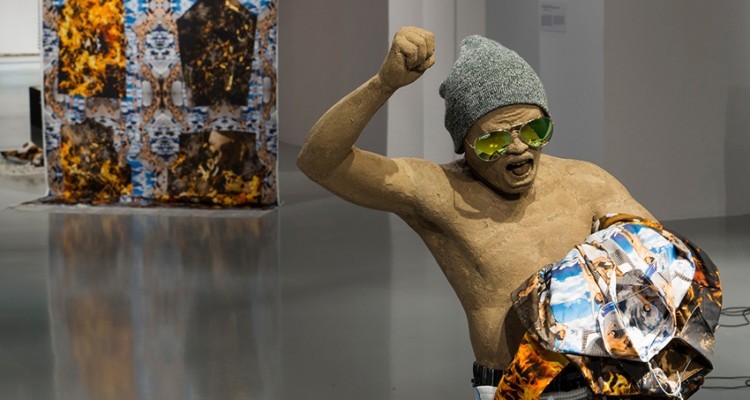Ines Doujak
Not Dressed For Conquering
15 Oct 2016 - 15 Jan 2017
INES DOUJAK
Not Dressed For Conquering
15 October 2016 – 15 January 2017
Let’s enter the a-historical and hermetic world of fashion to dirty its surface.
For the exhibition Ines Doujak. Not Dressed For Conquering, Württembergischer Kunstverein temporarily assumes the guise of a fashion store – to be precise, an assortment of various pop-up stores.
The show is based on the long-term Loomshuttles / Warpaths project by Austrian artist Ines Doujak (*1959) that, in different forms and formats, explores the links between textiles, fashion, colonialism, violence and globalized production conditions. It comprises Doujak’s "eccentric archive" that focuses on the history of globalization based on textiles from the Andean region; an open-ended series of sculptures, performances, writings and video works along with various, constantly evolving fashion collections.
The exhibition Not Dressed For Conquering features a selection of all these elements, reorganizing and extending them. The focus is on eight fashion collections showcased in the specially designed pop-up stores, each following different themes and motifs. Among them, the fire of burning factories and the burnout – in the literal sense too – of low-wage workers, animal and human skins, carnival and masquerade, and the devil himself. Under scrutiny are the supply chains of global trade, tightly organized by means of barcodes, automated cranes, containers and mega ships, or the long history of degrading workers to the level of "intelligent apes".
The collections consist of fabrics in which the various themes and motifs are directly inscribed and of patterns, garments, outfits and accessories derived from them, but also of writings, publications, objects, videos and pieces of dance and music in which patterns are transformed and translated into motion and sound.
Employing the glamour of the fashion world, Doujak not only spotlights the exploitative structures, gender and class orders of haute couture and mass-market clothing. Harking back to the resistant, anarchistic practices of textile design ranging from Andean weaving traditions to Dapper Dan, the iconic New York tailor to the eighties’ hip hop scene, she creates another, a different fashion that counteracts the status quo. This idea is also embodied by a group of "looters" and "rioters" who act as a kind of inverted gatekeeper at the various pop-up stores.
This other, resistant fashion again is the focal point of a number of performances and workshops taking place during the exhibition, combining tailoring, dance, music, film and politics.
Not Dressed For Conquering
15 October 2016 – 15 January 2017
Let’s enter the a-historical and hermetic world of fashion to dirty its surface.
For the exhibition Ines Doujak. Not Dressed For Conquering, Württembergischer Kunstverein temporarily assumes the guise of a fashion store – to be precise, an assortment of various pop-up stores.
The show is based on the long-term Loomshuttles / Warpaths project by Austrian artist Ines Doujak (*1959) that, in different forms and formats, explores the links between textiles, fashion, colonialism, violence and globalized production conditions. It comprises Doujak’s "eccentric archive" that focuses on the history of globalization based on textiles from the Andean region; an open-ended series of sculptures, performances, writings and video works along with various, constantly evolving fashion collections.
The exhibition Not Dressed For Conquering features a selection of all these elements, reorganizing and extending them. The focus is on eight fashion collections showcased in the specially designed pop-up stores, each following different themes and motifs. Among them, the fire of burning factories and the burnout – in the literal sense too – of low-wage workers, animal and human skins, carnival and masquerade, and the devil himself. Under scrutiny are the supply chains of global trade, tightly organized by means of barcodes, automated cranes, containers and mega ships, or the long history of degrading workers to the level of "intelligent apes".
The collections consist of fabrics in which the various themes and motifs are directly inscribed and of patterns, garments, outfits and accessories derived from them, but also of writings, publications, objects, videos and pieces of dance and music in which patterns are transformed and translated into motion and sound.
Employing the glamour of the fashion world, Doujak not only spotlights the exploitative structures, gender and class orders of haute couture and mass-market clothing. Harking back to the resistant, anarchistic practices of textile design ranging from Andean weaving traditions to Dapper Dan, the iconic New York tailor to the eighties’ hip hop scene, she creates another, a different fashion that counteracts the status quo. This idea is also embodied by a group of "looters" and "rioters" who act as a kind of inverted gatekeeper at the various pop-up stores.
This other, resistant fashion again is the focal point of a number of performances and workshops taking place during the exhibition, combining tailoring, dance, music, film and politics.

